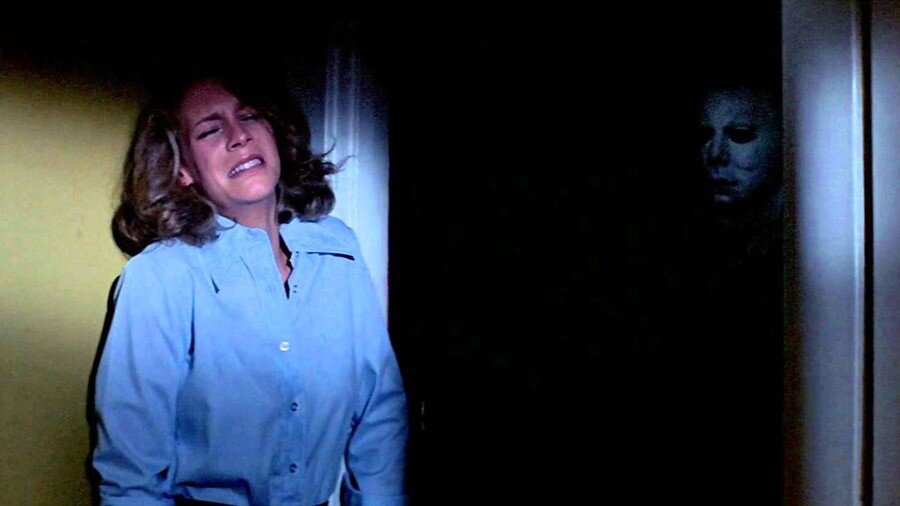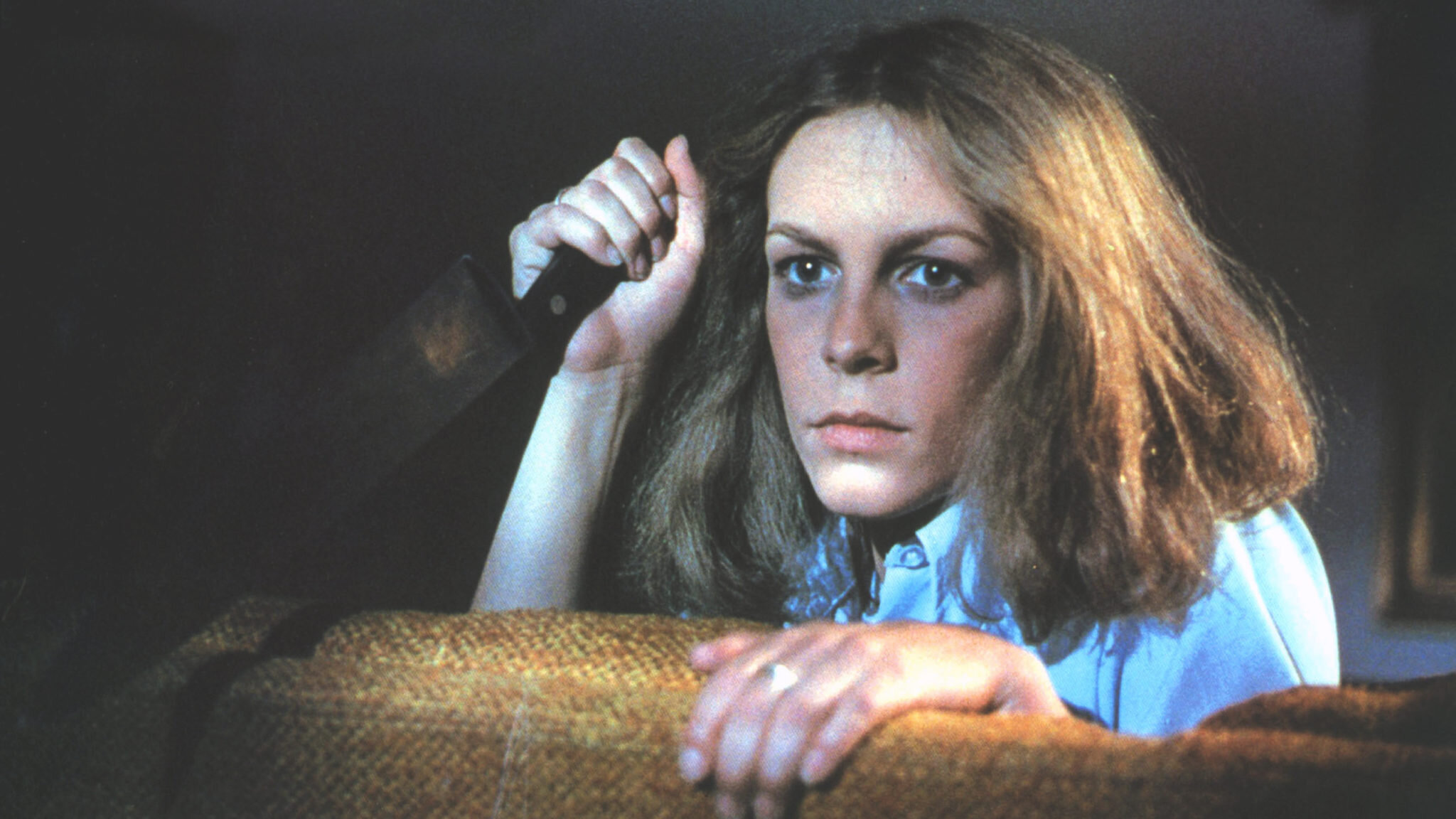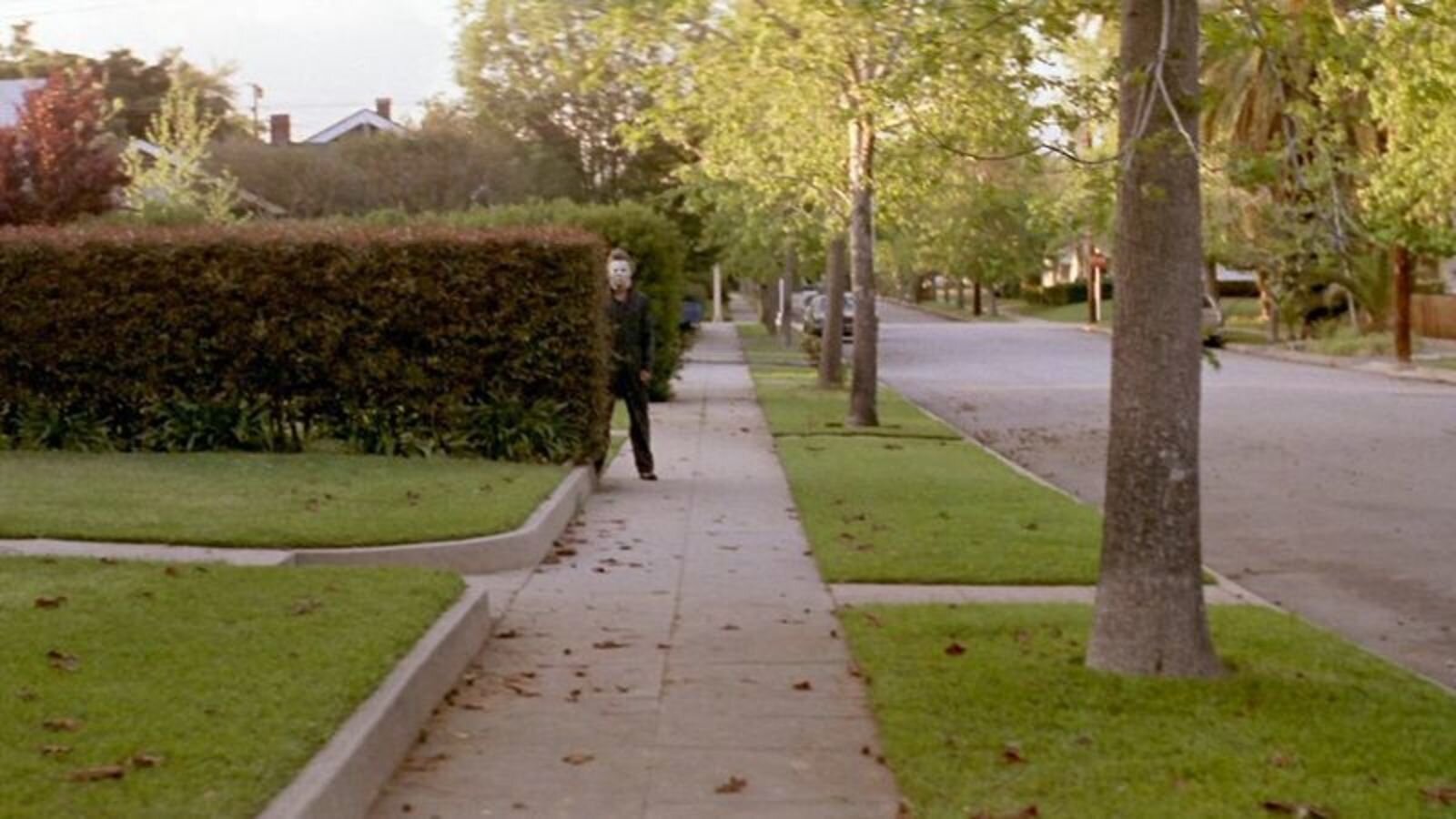[Film Review] Halloween (1978)
Spawning many sequels, covering more than one timeline, and bringing Jamie Lee Curtis back from the dead more times than you can count, there’s no denying the impact that the Halloween (1978) series has had on the world of horror. In the first entry, director and co-writer John Carpenter, along with Debra Hill, introduced us to the iconic, silent, masked killer Michael Myers.
As opening scenes go, the first few minutes of Halloween are a perfect introduction to the silent stalking killer who always waits for the ideal moment to strike before taking on his prey. We see Michael’s older sister Judith having some fun with her boyfriend on the couch before they decide to retire upstairs. We view them through the eyes of an observer, who we soon find out is Michael, breathing heavily as he peers through the window. The observer sneaks inside, retrieves a large knife from a kitchen drawer, and creeps upstairs after Judith’s boyfriend leaves. En route, the unseen figure pops on a small clown mask, meaning the viewer’s vision is obscured through two small eye holes.
Judith sits naked, brushing her hair at her dressing table. She recognises her killer, screaming “Michael!” before the knife springs into relentless action. The killer then flees, as a car pulls up outside the house containing Judith’s parents. Our killer is unmasked, revealed to be nothing more than a child, holding a knife almost as big as themselves. The brutality of the killer teamed with the reveal that a child is behind the murder sets us up perfectly for the creeping unease that we’re about to experience over the next 91 minutes..
The bulk of our story is told fifteen years later when Michael escapes from a sanitarium. Dr Loomis (who is treating Michael), is convinced that he will return to his hometown of Haddonfield to finish what he started on Halloween night 15 years ago, and so heads to the town with the hopes of stopping him l before he gets his hands on anything too stabby.
But the main focus of Halloween, and one of the most classic examples of the final girl, is Laurie Strode. Laurie is a high school student, an excellent babysitter, and portrayed as the most innocent of her friend group. While her friends are interested in hooking up with their boyfriends, avoiding work, drinking alcohol and doing drugs, Laurie is making plans to knit and carve pumpkins while babysitting on Halloween night.
While John Carpenter certainly didn’t invent the slasher movie, there’s no denying that Halloween reshaped the horror genre. Films that came before such as Psycho (1960), Black Christmas (1974), and The Texas Chain Saw Massacre (1974) definitely marked the beginning of the slasher sub-genre, but Halloween brought the slasher killer right onto our streets. Those slashers that preceded Halloween focussed on one location, often remote or separate from everyday society, allowing the killers to pick off their victims with ease.
In Halloween, Michael rocks back into Haddonfield and begins to stalk Laurie in the daytime. He follows her around town, lurking in the distance as she sits in the classroom, driving past her and her friends as they walk home from school, follows Annie’s car as she gives Laurie a ride, and even stands outside Laurie’s window when she arrives home. Rather than relying on the common horror tropes of isolation, or people getting into dangerous situations by wandering off the beaten path, Halloween showed audiences that evil can be lurking anywhere. Laurie catches Michael stalking her on many occasions, but because Michael chooses to strike on Halloween, it allows him to blend into the background, meaning her friends tell her not to worry. In Halloween, the isolation comes for Laurie when she knows there is something wrong, but she’s unable to find anyone else to share her concern.
The slow stalking builds until Halloween night when darkness falls across Haddonfield, and Laurie is separated from her friends. Annie, Lynda, and her boyfriend Bob all lose their lives to Michael inside the Wallace house, where Annie is meant to be babysitting. With reliable Laurie caring for Lindsey Wallace and her own charge, Tommy Doyle, her friends are free to break all the horror movie rules and suffer the consequences.
Unlike more modern slashers, Halloween lacks the gore and blood that audiences may expect these days. While both Judith and Bob are stabbed to death, there is no blood or focus on the injuries. Instead, the focus is on the blankness with which Michael observes his victims. There’s no emotion in his vacant eyes, and the mask he chooses to wear is void of any expression. He seems to get no joy from his killing, but rather it is something he feels he has to do. And in Halloween itself, we’re never given any hint of motive for Michael’s killings other than he enjoys terrorising Haddonfield.
The building tension that we experience in the first two acts of Halloween switches to breathless action when Laurie heads over to the Wallace house and finds the bodies of all her friends. Much like his sister Judith before her, Michael has set his sights on Laurie, and finally makes his move on her. Laurie has to face off against Michael with no knowledge of why he’s trying to kill her, and no support or protection from her friends. This final chase produces some of the most iconic scenes in the whole movie including Laurie stabbing Michael with both a knitting needle and a coat hanger, Michael fighting his way into a bedroom closet, and Michael sitting up rigidly in the background of the shot after Laurie thinks she’s beaten him.
All in all, Halloween is an iconic slasher. Its use of daylight and the apparent safety of suburbia with a danger always lurking in the background makes it stand out from the typical slasher conventions we are used to. Michael’s lack of motive or explanatory backstory might be off putting to those who like to get to know their killers a little more, but really, we learn all we need to know about Michael in those opening few minutes.
In truth, Halloween is about Laurie. We’re not supposed to connect with Michael because he is the bad guy. Instead, we’re supposed to build a relationship with our wonderful, ass-kicking, and brave final girl. Everyone deserves one good scare on Halloween, and John Carpenter’s 1978 slasher is perfect for Halloween night or any time of the year.







![[Ghouls Podcast] Maniac (2012) with Zoë Rose Smith and Iona Smith](https://images.squarespace-cdn.com/content/v1/5fe76a518d20536a3fbd7246/1696356006789-NYTG9N3IXCW9ZTIJPLX2/maniac.jpg)
![[Editorial] Metal Heart: Body Dysmorphia As A Battle Ground In Tetsuo: The Iron Man (1989)](https://images.squarespace-cdn.com/content/v1/5fe76a518d20536a3fbd7246/1690190127461-X6NOJRAALKNRZY689B1K/Screenshot+2023-07-24+at+10.08.27.png)
![[Editorial] Editor’s Note: Making a slash back into September](https://images.squarespace-cdn.com/content/v1/5fe76a518d20536a3fbd7246/1694354202849-UZE538XIF4KW0KHCNTWS/MV5BMTk0NTk2Mzg1Ml5BMl5BanBnXkFtZTcwMDU2NTA4Nw%40%40._V1_.jpg)
![[Editorial] If Looks Could Kill: Tom Savini’s Practical Effects in Maniac (1980)](https://images.squarespace-cdn.com/content/v1/5fe76a518d20536a3fbd7246/1694952175495-WTKWRE3TYDARDJCJBO9V/Screenshot+2023-09-17+at+12.57.55.png)
![[Editorial] Eat Shit and Die: Watching The Human Centipede (2009) in Post-Roe America ](https://images.squarespace-cdn.com/content/v1/5fe76a518d20536a3fbd7246/1691245606758-4W9NZWE9VZPRV697KH5U/human_centipede_first_sequence.original.jpg)
![[Editorial] 8 Body Horror Short films](https://images.squarespace-cdn.com/content/v1/5fe76a518d20536a3fbd7246/1690838270920-HWA5RSA57QYXJ5Y8RT2X/Screenshot+2023-07-31+at+22.16.28.png)
![[Editorial] 5 Slasher Short Horror Films](https://images.squarespace-cdn.com/content/v1/5fe76a518d20536a3fbd7246/1696358009946-N8MEV989O1PAHUYYMAWK/Screenshot+2023-10-03+at+19.33.19.png)
![[Editorial] 8 Mind Horror Short films](https://images.squarespace-cdn.com/content/v1/5fe76a518d20536a3fbd7246/1693504844681-VPU4QKVYC159AA81EPOW/Screenshot+2023-08-31+at+19.00.36.png)
![[Editorial] Deeper Cuts: 13 Non-Typical Slashers](https://images.squarespace-cdn.com/content/v1/5fe76a518d20536a3fbd7246/1694951568990-C37K3Z3TZ5SZFIF7GCGY/Curtains-1983-Lesleh-Donaldson.jpg)
![[Editorial] Top 15 Female-Focused Body Horror Films](https://images.squarespace-cdn.com/content/v1/5fe76a518d20536a3fbd7246/1689081174887-XXNGKBISKLR0QR2HDPA7/download.jpeg)
![[Editorial] Top 15 Female-Focused Mind Horror Films](https://images.squarespace-cdn.com/content/v1/5fe76a518d20536a3fbd7246/1691247166903-S47IBEG7M69QXXGDCJBO/Image+5.jpg)

![[Film Review] V/H/S/85 (2023)](https://images.squarespace-cdn.com/content/v1/5fe76a518d20536a3fbd7246/1697455043249-K64FG0QFAFVOMFHFSECM/MV5BMDVkYmNlNDMtNGQwMS00OThjLTlhZjctZWQ5MzFkZWQxNjY3XkEyXkFqcGdeQXVyMTUzMTg2ODkz._V1_.jpg)
![[Film Review] Sympathy for the Devil (2023)](https://images.squarespace-cdn.com/content/v1/5fe76a518d20536a3fbd7246/1697186986143-QDVLQZH6517LLST682T8/Screenshot+2023-10-13+at+09.48.52.png)
![[Film Review] Perpetrator (2023)](https://images.squarespace-cdn.com/content/v1/5fe76a518d20536a3fbd7246/1695483561785-VT1MZOMRR7Z1HJODF6H0/Screenshot+2023-09-23+at+16.32.55.png)
![[Film Review] A Wounded Fawn (2022)](https://images.squarespace-cdn.com/content/v1/5fe76a518d20536a3fbd7246/1695484054446-7R9YKPA0L5ZBHJH4M8BL/Screenshot+2023-09-23+at+16.42.24.png)
![[Film Review] Mercy Falls (2023)](https://images.squarespace-cdn.com/content/v1/5fe76a518d20536a3fbd7246/1695482997293-E97CW9IABZHT2CPWAJRP/Screenshot+2023-09-23+at+16.27.27.png)
![[Film Review] Elevator Game (2023)](https://images.squarespace-cdn.com/content/v1/5fe76a518d20536a3fbd7246/1696440997551-MEV0YZSC7A7GW4UXM5FT/Screenshot+2023-10-04+at+18.31.42.png)
![[Film Review] Kill Your Lover (2023)](https://images.squarespace-cdn.com/content/v1/5fe76a518d20536a3fbd7246/1697465940337-T55VQJWAN4CHHJMXLK32/56_PAIGE_GILMOUR_DAKOTA_HALLWAY_CONFRONTATION.png)
![[Film Review] Shaky Shivers (2022)](https://images.squarespace-cdn.com/content/v1/5fe76a518d20536a3fbd7246/1696442594997-XMJSOKZ9G63TBO8QW47O/Screenshot+2023-10-04+at+18.59.33.png)






















![[Editorial] 10 Films & Events to Catch at Soho Horror Film Fest 2023](https://images.squarespace-cdn.com/content/v1/5fe76a518d20536a3fbd7246/1700819417135-299R7L4P0B676AD3RO1X/Screenshot+2023-11-24+at+09.41.52.png)
![[Editorial] 9 Horror Nintendo Switch Games To Play](https://images.squarespace-cdn.com/content/v1/5fe76a518d20536a3fbd7246/1697214470057-3XZXX8N4LYIMDFWS6Z3P/Screenshot+2023-10-13+at+17.20.13.png)
![[Mother of Fears] Mothering in Silence in A Quiet Place (2018)](https://images.squarespace-cdn.com/content/v1/5fe76a518d20536a3fbd7246/1696445921315-HZJ2DZYQIH6VVWXBO2YL/Screenshot+2023-10-04+at+19.52.29.png)
![[Editorial] 5 Female Focused Horror Book Recommendations](https://images.squarespace-cdn.com/content/v1/5fe76a518d20536a3fbd7246/1696441981361-52EQCTJ7AT2QF1927GM7/919xtm6d3fL._AC_UF894%2C1000_QL80_.jpg)
![[Editorial] 9 Best Slashers Released Within 10 Years of Scream (1996)](https://images.squarespace-cdn.com/content/v1/5fe76a518d20536a3fbd7246/1695478839037-LOFHGVM3H6BMSZW7G83M/Screenshot+2023-09-23+at+15.15.11.png)
![[Mother of Fears] Mother Vs. Monster in Silent Hill (2006)](https://images.squarespace-cdn.com/content/v1/5fe76a518d20536a3fbd7246/1695485781119-H6GNP0G3J2TLPAOIABV7/Screenshot+2023-09-23+at+17.11.56.png)
![[Editorial] 9 Terrifying Cerebral Visions in Horror Movies](https://images.squarespace-cdn.com/content/v1/5fe76a518d20536a3fbd7246/1693509801235-X23OL50T1DVGECH0ZJK2/MV5BMjQ0MTg2MjQ4MV5BMl5BanBnXkFtZTgwMTU3NDgxMTI%40._V1_.jpg)
![[Mother of Fears] I Don’t Wanna Be Buried in a Pet Sematary (1989) and (2019)](https://images.squarespace-cdn.com/content/v1/5fe76a518d20536a3fbd7246/1691328766069-QFNAVJOMFZVZ5CLU1RWM/Screenshot+2023-08-06+at+14.23.13.png)

I can sometimes go months without having a panic attack. Unfortunately, this means that when they do happen, they often feel like they come out of nowhere. They can come on so fast and hard it’s like being hit by a bus, my breath escapes my body, and I can’t get it back.